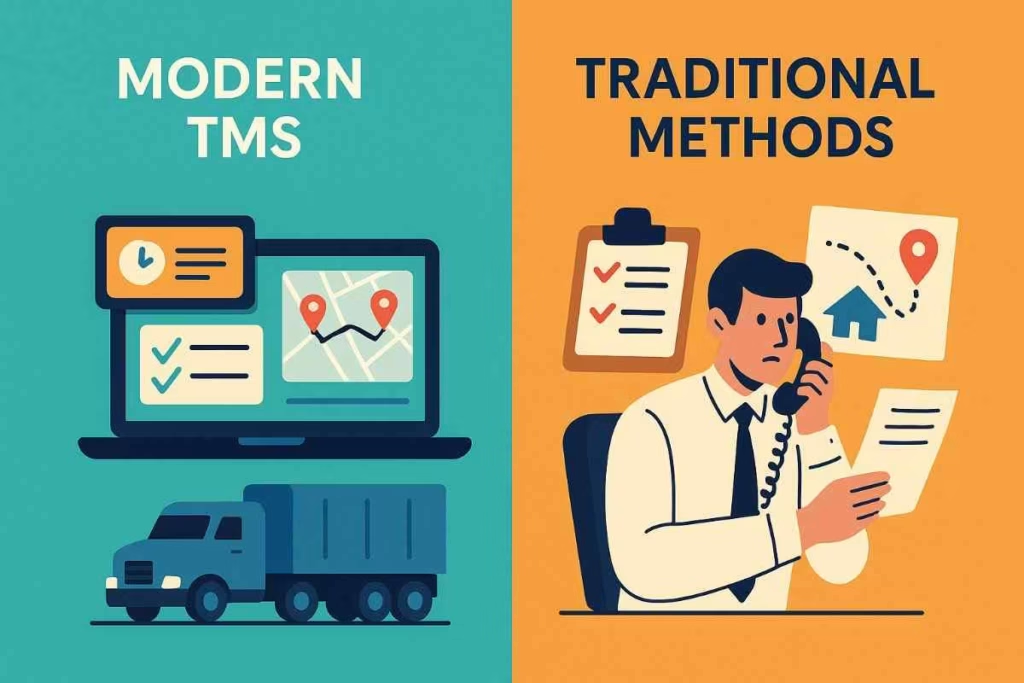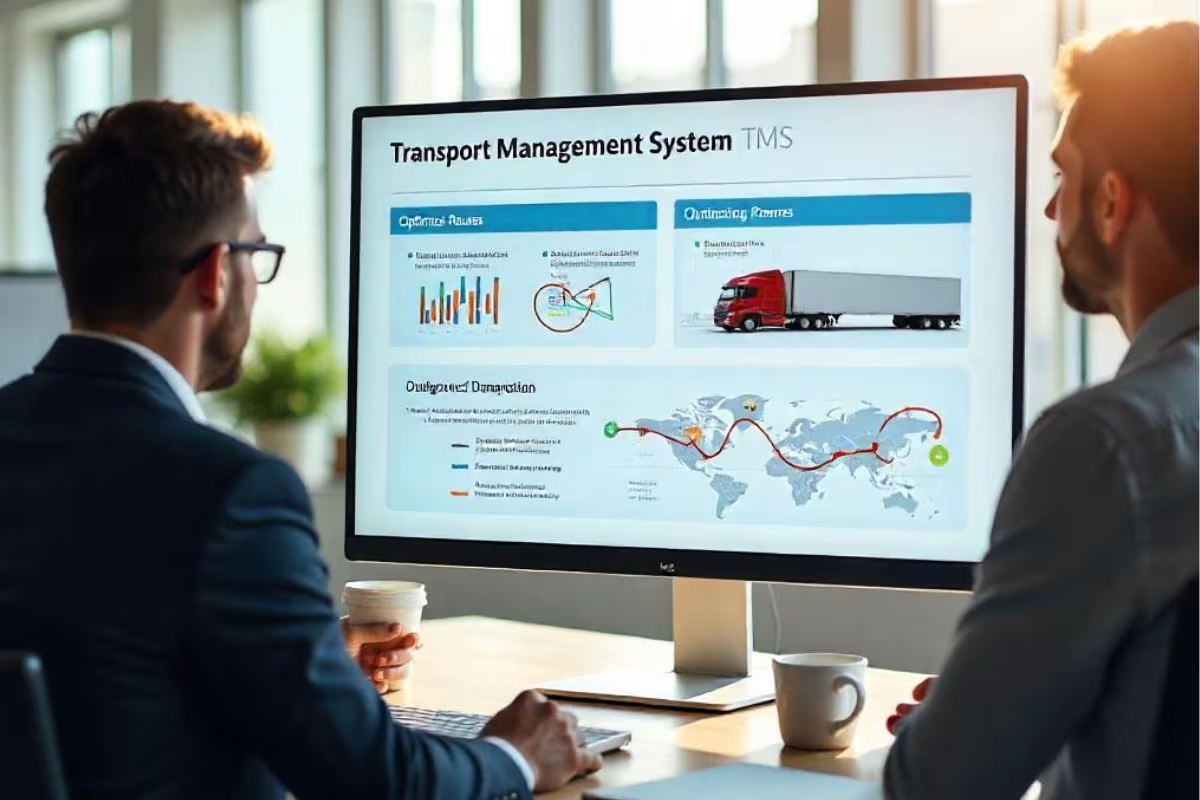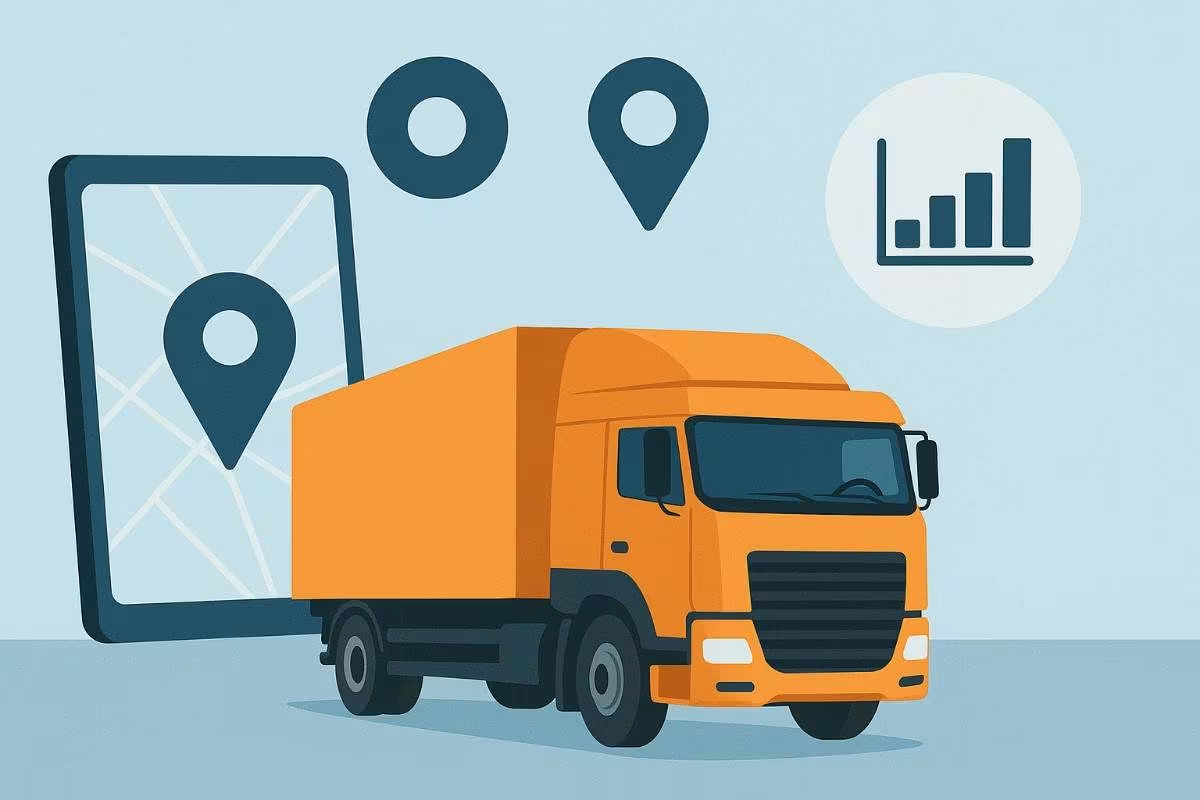Introduction to Transport Management System for Carriers

As the logistics industry continues to evolve in 2025, staying competitive as a carrier requires more than just trucks and talent. It takes precision, speed, data, and a smart system to bring it all together. That’s where Transport Management Systems for carriers come in—a modern digital solution designed to optimize operations, cut costs, and improve delivery performance.
In this comprehensive guide, you’ll learn what a TMS is, the key features that matter most to carriers, how to measure its ROI, and how to choose the right TMS platform for your fleet. We’ll also walk through integration strategies, onboarding best practices, and future technology trends shaping the world of transportation logistics.
What is a Transport Management System (TMS)?
A Transport Management System (TMS) is a digital platform that helps carriers plan, manage, and optimize their logistics and fleet operations. In simple terms, it replaces manual processes—like phone calls, paperwork, and spreadsheets—with automated tools.
In a carrier’s daily operations, a TMS software fits right at the center. It automates load assignments, tracks drivers in real time, digitizes documents, and ensures compliance. Everything happens in one place, saving time and reducing errors.
Core components of a TMS for carriers include route optimization, driver communication, real-time GPS tracking, e-document management, and analytics dashboards for smart decisions.
Also Read – What Is a Transport Management System and How Does It Work?
TMS Software vs Traditional Methods: A Quick Comparison

Curious about how today’s carrier TMS solutions outperform traditional transport management practices? The following comparison breaks down the critical differences between legacy logistics systems and a modern transportation management system for carriers, showcasing how digital transformation drives efficiency, reduces operational costs, and enhances shipment visibility.
| Aspect | Traditional Methods | TMS Software |
| Load Assignment | Manual, phone calls | Automated with real-time scheduling |
| Driver Tracking | Periodic check-ins via phone | Live GPS tracking and status updates |
| Document Handling | Paper-based, prone to loss | Digital uploads and storage |
| Compliance & Logs | Manual logging | Automated and audit-ready |
| Reporting & Insights | Difficult and time-consuming | Instant dashboards and reports |
With a TMS, carriers can shift from reactive to proactive fleet management—leading to faster decisions, better performance, and higher efficiency.
Why Is a Transportation Management System Important in 2025?
A transportation management system allows carriers to streamline dispatch operations, reduce operational costs, and increase supply chain efficiency. With increasing industry demands in 2025, TMS software helps automate tasks like route planning, driver assignment, and real-time shipment tracking—saving valuable time and reducing manual errors. It also supports regulatory compliance, provides critical insights through analytics, and enhances communication across teams. In a logistics landscape where speed, transparency, and accuracy matter more than ever, a TMS is no longer optional—it’s a necessity for modern carriers to stay competitive.
Top Benefits of Using TMS for Carriers
A Transport Management System for carriers isn’t just a convenience—it’s a game-changer in today’s competitive logistics environment. By replacing manual tasks with smart automation, a TMS allows carriers to operate more efficiently, make informed decisions, and increase overall profitability.
Here are the key benefits carriers can expect from using a modern TMS:
- Faster Load Scheduling
With built-in trucking dispatch software, TMS platforms automate load assignments and reduce the time it takes to schedule trips. This helps dispatchers assign loads quickly and accurately, minimizing delays and improving driver utilization. - Optimized Fuel Usage
A TMS uses advanced route planning tools and integrates with truck tracking software to help identify the shortest and most fuel-efficient routes. As a result, carriers can cut down on unnecessary fuel consumption and reduce operational waste. - Full Fleet Visibility in Real Time
Live tracking and real-time fleet management tools give dispatchers complete oversight of vehicle locations, status updates, and driver performance—enabling fast, data-driven decisions when on-road challenges arise. - Lower Operational Costs
A TMS reduces dependency on manual processes by digitizing workflows like load document management, billing, and reporting. This reduces administrative overhead and lowers the chances of human error. - Improved Regulatory Compliance
Features such as automated HOS logging, IFTA fuel tax reports, and e-signature capabilities ensure your operations stay compliant with transportation laws—without the hassle of manual recordkeeping. - Increased Profit Margins
By eliminating inefficiencies in dispatching, routing, and document handling, a TMS helps cut operational expenses. These savings, combined with more accurate load matching, directly contribute to higher profitability. - Higher Driver Satisfaction & Retention
With access to a dedicated driver mobile app, drivers receive load details, communicate instantly with dispatchers, and upload documents—all from their smartphones. This enhances the driver experience, reduces stress, and improves retention rates. - Actionable Performance Insights
Using TMS analytics software, carriers can track KPIs like fuel use, delivery times, and idle hours. These insights support better planning and long-term business growth. - Simple and Fast Onboarding
Most TMS platforms today support easy onboarding with intuitive interfaces and fast implementation. This allows teams to start using the system without a steep learning curve.
A well-implemented transportation management system for carriers doesn’t just streamline operations—it creates long-term business value through automation, visibility, and cost control.
What are the Features of a Transport Management System?

A Transport Management System (TMS) for carriers is built to streamline logistics, improve visibility, and reduce operational friction. It combines automation, communication, and analytics to help carriers scale faster and operate more efficiently.
Here are the top features of a TMS designed for carriers:
- Automated Load Assignment & Dispatching
The trucking dispatch software within a TMS uses intelligent automation to assign loads to available drivers in real-time. This minimizes delays, eliminates manual scheduling, and improves on-time deliveries. - Truck Load Management Software
With truck load management tools, carriers can organize freight efficiently, reduce empty miles, and ensure every truck is running at full capacity. - Driver Mobile App
The TMS driver app gives drivers instant access to load details, real-time updates, and messaging tools. It simplifies communication and helps them stay compliant on the road. - Truck Tracking Software
Real-time truck tracking software allows carriers to monitor fleet movement, optimize routing, and improve security through live GPS updates and alerts.
Also Read – Truck Tracking Software: The Complete Guide to Enhancing Fleet Visibility, Safety & Compliance [2025] - Route Optimization & Compliance Management
TMS platforms help carriers plan cost-efficient routes while maintaining compliance with HOS, IFTA, and ELD regulations through automated reporting and reminders. - Load Documents Management
Eliminate paper-based delays with secure load document management. Upload and access BOLs, invoices, proof of delivery, and inspection reports directly through the system. - TMS Analytics Software
Powerful TMS analytics dashboards provide performance data, fuel usage stats, delivery times, and driver behavior insights—helping carriers make data-driven decisions. - Financial Management Integration
Many TMS platforms include tools to handle billing, payroll, and fuel expenses, giving fleet managers one centralized platform for financial oversight. - Easy Onboarding
A well-designed TMS includes intuitive onboarding workflows that simplify adoption. Carriers and drivers can get started with minimal training and begin seeing results faster.
How does a Transport Management System work?
A Transportation Management System (TMS) works by automating and coordinating the end-to-end process of planning, executing, and analyzing the movement of goods across the supply chain. It acts as a digital hub that connects carriers, dispatchers, drivers, and logistics teams—streamlining operations through centralized control, data integration, and real-time visibility.
Here’s how a TMS works in a typical carrier operation:
1. Order Integration and Shipment Planning
The process begins when shipment orders are entered into the system—either manually or via integration with other platforms like ERPs (Enterprise Resource Planning) or WMS (Warehouse Management Systems). The TMS analyzes this information to determine the most efficient transportation plan.
It evaluates factors like delivery windows, route distances, cargo type, and cost constraints to select the best carrier, mode (LTL, FTL, intermodal), and route for each shipment. This step ensures optimized planning before a truck even hits the road.
2. Carrier Assignment and Load Tendering
Once a shipment plan is created, the TMS assigns loads to carriers based on availability, pricing, service levels, or historical performance. It can automatically tender loads to preferred carriers or allow competitive bidding within a carrier network. Load confirmations, rate agreements, and documentation are all managed digitally—cutting down on phone calls and paperwork.
3. Shipment Execution and Real-Time Tracking
As the shipment progresses, the TMS tracks its movement in real time using GPS data, ELDs (Electronic Logging Devices), and driver mobile apps. Dispatchers and managers can view the exact location of each vehicle, monitor driver status, and respond quickly to route changes, delays, or exceptions.
This level of visibility allows for proactive decision-making and minimizes service disruptions.
4. Document Management and Billing
After delivery, the TMS automatically captures relevant documents such as Proof of Delivery (POD), bills of lading, and freight invoices. These documents are validated against load details to initiate billing or payment processes.
By digitizing this part of the workflow, a TMS reduces manual errors, speeds up settlements, and improves compliance.
5. Data Analysis and Performance Optimization
Finally, the TMS compiles operational data to generate key performance metrics like on-time delivery rates, cost per mile, fuel efficiency, and driver productivity. These insights help carriers identify bottlenecks, reduce costs, and improve future planning.
This data-driven feedback loop is one of the most valuable aspects of a TMS—supporting continuous improvement across all transportation activities.
A transportation management system works by streamlining every stage of the shipping process—from planning and carrier selection to tracking, documentation, and performance analysis. By centralizing operations and enabling real-time visibility, a TMS helps carriers reduce costs, improve efficiency, and deliver better service across the supply chain.
Measuring the Return on Investment (ROI) of Your Transportation Management System

Understanding the return on investment (ROI) of a Transport Management System for carriers is essential before making the leap into automation. A TMS isn’t just an expense—it’s a tool designed to reduce costs, save time, and improve operational efficiency. Calculating its ROI ensures you’re making a smart, data-backed decision.
Step 1: Identify Pre-TMS Operational Costs
Start by listing the areas where your business currently loses time or money. Common cost centers for carriers without a TMS software for carriers include:
- Hours spent on manual dispatching and scheduling
- Excess fuel usage due to non-optimized routes
- Fines and fees from compliance issues
- Labor required for handling physical documents
- Delivery delays impacting customer trust and retention
These areas are prime opportunities for automation and optimization with a logistics management software.
Step 2: Estimate Improvements After TMS Implementation
Once you deploy a TMS platform, track the measurable changes in your operations. A well-integrated truck dispatch system can lead to:
- Up to 20–30% savings in fuel through smarter route planning
- Reduced dispatch time with automated load assignments
- Reduced vehicle downtime by leveraging real-time GPS fleet monitoring
- Lower administrative burden with digital document handling
- Minimized compliance risks via automated logging and reporting
These improvements directly contribute to stronger financial performance.
Step 3: Use a Simple ROI Formula
To put numbers to these savings, use this formula:
ROI (%) = [(Total Annual Savings – TMS Annual Cost) ÷ TMS Annual Cost] × 100
Example:
If your business saves $50,000 per year and the TMS costs $15,000:
ROI = [($50,000 – $15,000) ÷ $15,000] × 100 = 233%
This indicates that for every $1 invested in the system, you receive $2.33 in return.
Step 4: Think Beyond Immediate Gains
While immediate savings are clear, a TMS solution also delivers long-term advantages, such as:
- Smarter capacity usage and fewer empty miles
- Better driver performance through real-time feedback
- Enhanced delivery accuracy and customer satisfaction
- Scalability as your fleet grows and operations expand
These long-term benefits continue to improve your margins over time, turning your TMS into a growth enabler.
Integration with Existing Carrier Systems
One of the most important strengths of a carrier TMS is its ability to work seamlessly with the systems and tools you’re already using. Instead of overhauling your entire operation, a modern TMS software for carriers acts as a central hub—streamlining workflows across dispatching, accounting, compliance, and customer service.
Seamless GPS and ELD Connectivity
A top-tier TMS platform easily integrates with GPS tracking devices and Electronic Logging Devices (ELDs). This connection ensures real-time location tracking, automated log management, and accurate reporting for Hours of Service (HOS) compliance. With this integration, carriers gain full visibility into their fleet without juggling multiple apps or hardware.
Compatibility with Accounting and CRM Tools
Many carriers already use tools like QuickBooks, Xero, or Salesforce to manage billing and customer relationships. A flexible TMS solution offers built-in integrations or APIs to sync data automatically—eliminating double entry, reducing human error, and ensuring that everything from invoices to fuel reimbursements stays up to date.
API Support and Mobile Accessibility
For growing fleets, adaptability is key. That’s why modern TMS software for carriers includes open APIs—allowing developers to connect custom systems, mobile apps, or third-party platforms directly to the TMS. Additionally, most systems offer mobile-friendly dashboards or dedicated driver apps, empowering field teams with live updates, route changes, and document uploads.
Benefits of Smooth System Integration
- No disruption to your current workflows
- Unified data access across departments
- Faster billing and reduced paperwork
- Improved driver experience with mobile support
- Enhanced communication between dispatchers, drivers, and customers
How to Choose the Best TMS for Carriers
How to choose the best TMS? Start by identifying your operational needs, comparing key features, and checking for integration capabilities with your existing systems. The best Transport Management System (TMS) should enhance your efficiency, reduce costs, and be easy to use for both dispatchers and drivers.
Steps to Choose the Best TMS:
- Define Your Business Needs
Start by assessing your current pain points. Do you struggle with manual dispatching, lack of real-time tracking, or paperwork delays? The best TMS will solve these challenges through automation, fleet tracking, and digital document management. - Look for Key TMS Features
The right TMS should offer:
- Driver mobile apps for instant communication
- Trucking dispatch software for automated load assignments
- TMS analytics software for tracking KPIs
- Truck load management tools for scheduling and optimization
- Fleet tracking platform for real-time vehicle updates
- Document management system for paperless operations
- Driver mobile apps for instant communication
- Check System Compatibility
Ensure the TMS integrates with your ELD systems, GPS tools, CRM, and accounting software. Compatibility reduces manual work and enhances accuracy across your operation. - Ask the Right Questions
When speaking to vendors, ask:
- Is the software scalable and cloud-based?
- How long is the onboarding process?
- Does it support real-time updates and mobile access?
- What kind of customer support is available?
- Is the software scalable and cloud-based?
- Avoid Common Pitfalls
Don’t choose a TMS that:
- Lacks mobile optimization
- Doesn’t offer integrations
- Has limited reporting tools
- Locks you into rigid, long-term contracts
- Lacks mobile optimization
- Test Before You Commit
The best TMS providers offer free trials or live demos. Use this to evaluate ease of use, speed, and overall user experience for your team.
Onboarding & Setup: How to Start Using a TMS Seamlessly
Adopting a Transport Management System (TMS) is a smart step for carriers—but how you onboard and set it up determines how quickly you’ll start seeing results. With the right approach, your team can be up and running with minimal disruption to your operations.
What Does TMS Onboarding Involve?
The onboarding process typically includes:
- Initial setup and customization based on your fleet size, load types, and operational workflows.
- Integration with existing carrier systems like GPS, ELD, accounting, and CRM tools.
- User role configuration, setting permissions for dispatchers, drivers, and managers.
- Transferring existing data such as active routes, client records, rate structures, and vehicle details into the new system.
Most top-tier TMS providers offer dedicated onboarding support to streamline these tasks and reduce setup errors.
Training Your Staff and Drivers
One of the most important steps is training. The best TMS platforms provide:
- Interactive tutorials and how-to guides
- Video walkthroughs for mobile apps and dashboards
- Live training sessions with support teams
Drivers are trained on mobile app features, such as receiving load info, uploading documents, and updating status in real time. Dispatchers learn how to assign loads, track trucks, manage compliance, and generate reports.
Ensuring a Smooth Rollout
To make the transition smooth:
- Start with a pilot team before rolling it out fleet-wide
- Collect initial feedback and fix any usability issues
- Monitor KPIs like dispatch time and driver response rates to measure improvement
- Maintain ongoing support and training as needed
Carriers that plan their onboarding process carefully often start seeing efficiency gains within weeks. Choosing a TMS provider that offers hands-on onboarding support is key to a stress-free implementation.
Why Fast Forward TMS is the Best TMS for Carriers
Choosing the right Transport Management System for carriers is more than just comparing features—it’s about selecting a partner that understands your operational challenges and supports your growth. Fast Forward TMS is built specifically for carriers, offering powerful tools with unmatched support to help streamline your entire transportation workflow.
What Makes Fast Forward TMS Different?
- Designed for Carriers: Fast Forward TMS is not a generic logistics tool. It’s purpose-built for trucking companies, ensuring that every feature—from load dispatching to compliance tracking—aligns with carrier needs.
- Easy-to-Use Interface: With a clean dashboard and intuitive design, your dispatchers, managers, and drivers can quickly adapt without steep learning curves.
- Mobile-First Experience: Our driver mobile app ensures your fleet stays connected in real time. From load updates to document uploads, everything is just a tap away.
- Reliable Support & Onboarding: Fast Forward offers hands-on onboarding, training, and ongoing support. Our team helps you every step of the way—from setup to scale-up.
- Real-Time Fleet Tracking & Analytics: Stay ahead with GPS tracking, load visibility, fuel usage monitoring, and performance dashboards—all in one place.
- Seamless Integrations: Whether you use ELDs, accounting software, or CRMs, Fast Forward TMS connects effortlessly with your existing systems.
- Trusted by Growing Fleets: Hundreds of small and mid-sized carriers across North America rely on Fast Forward to optimize their logistics operations and improve ROI.
When you choose Fast Forward TMS, you’re not just getting a product—you’re gaining a strategic partner dedicated to your efficiency, compliance, and growth.
The Future of TMS and Digital Fleet Management
The transportation industry is evolving rapidly, and so is the role of Transport Management Systems for carriers. As fleets grow and customer demands rise, modern TMS platforms are becoming smarter, faster, and more predictive. Understanding where TMS technology is heading can help carriers stay competitive and future-proof their operations.
AI-Powered Automation
Artificial intelligence is already transforming how carriers manage loads and routes. Advanced TMS software for carriers will soon be able to predict delays, auto-assign loads based on driver availability, and even recommend cost-saving route changes in real-time—all powered by AI and machine learning.
IoT and Real-Time Sensor Data
The rise of IoT (Internet of Things) is making fleet tracking platforms smarter than ever. Sensors on trucks can now track tire pressure, fuel efficiency, engine performance, and cargo temperature. This data is integrated into TMS dashboards, helping carriers make informed decisions on maintenance and safety.
Autonomous Dispatching
We’re moving toward semi-autonomous dispatch systems where TMS platforms automatically manage schedules, match loads, and update drivers—minimizing manual work and human error.
Enhanced Mobile Experiences
Driver mobile apps are becoming more robust, with built-in voice commands, document scanning, real-time navigation, and automated compliance updates. The goal is to empower drivers with everything they need—right from their smartphones.
Blockchain & Data Security
Future-ready TMS platforms will increasingly use blockchain to ensure secure data transfer, tamper-proof documentation, and transparent transaction logs across the supply chain.
Preparing for the Future
To thrive in this digital era, carriers must adopt a scalable, cloud-based TMS that supports integrations, adapts to new technologies, and offers continuous updates. Forward-thinking fleets are already making the switch to stay ahead of industry trends and meet tomorrow’s demands today.
Conclusion: Is It Time to Adopt a TMS?
As the logistics industry grows more complex, Transport Management Systems for carriers have become essential—not optional. From solving everyday operational challenges to unlocking real-time visibility, cost control, and long-term growth, a TMS gives carriers a competitive edge in 2025 and beyond.
Throughout this guide, we’ve explored the core features of a TMS, its key benefits, how to measure its ROI, and how to integrate it with your current systems. You’ve also learned how to choose the best TMS, how to roll it out efficiently, and what the future holds for digital fleet management. One thing is clear: a well-implemented TMS can transform how carriers operate—saving time, reducing expenses, and boosting overall performance.
If you’re ready to modernize your operations and stay ahead in the fast-moving transportation landscape, now is the time to explore a smart, scalable solution. Fast Forward TMS is here to help you make that leap—with intuitive features, real-time insights, and industry-leading support tailored specifically for carriers.
Start your journey today—book a free demo or connect with our experts to learn how Fast Forward TMS can empower your fleet.




